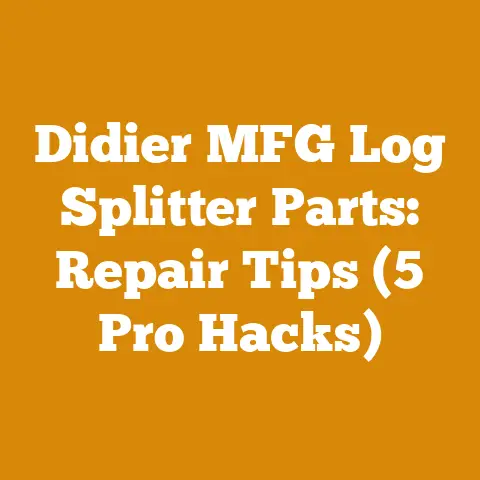Flagging Trees Guide: Tape Colors & Meanings (Logging Codes Explained)
The crisp autumn air bites at my cheeks as I walk the back forty, assessing the stand of oak and maple.
The leaves are putting on their final show, a riot of reds and golds before winter’s stark embrace.
It’s a beautiful sight, but today, beauty takes a backseat to practicality.
I’m planning a small-scale logging operation, thinning out the weaker trees to give the stronger ones room to thrive.
And that means understanding the language of the woods: flagging tape.
For years, I’ve been managing my own woodlot, cutting firewood for my home, and occasionally selling some to neighbors.
Over time, I’ve learned that proper planning and a keen understanding of costs are as crucial as a sharp chainsaw.
This isn’t just about swinging an axe; it’s about sustainable forestry, responsible land management, and making sure your wood processing efforts don’t end up costing you more than they’re worth.
This guide is born from my own experiences, the lessons learned from seasoned loggers, and a whole lot of research into the often-opaque world of timber prices, equipment costs, and labor rates.
So, grab a cup of coffee, and let’s dive into the world of flagging trees, understanding logging codes, and, most importantly, budgeting your wood processing project.
Understanding Flagging Tape: The Language of the Woods
Flagging tape might seem like a simple strip of plastic, but in the logging world, it’s a vital communication tool.
Different colors and patterns convey specific messages, ensuring that everyone involved in the harvesting process is on the same page.
Misinterpreting these signals can lead to costly mistakes, environmental damage, or even safety hazards.
Why Use Flagging Tape?
Flagging tape serves several critical purposes:
- Marking Boundaries: Defining property lines, harvest areas, or sensitive zones.
- Identifying Trees: Indicating which trees are to be cut, left standing, or treated in a specific way.
- Highlighting Hazards: Warning of potential dangers, such as unstable trees, steep slopes, or underground utilities.
- Guiding Operations: Directing skidders, forwarders, or other equipment along designated paths.
- Common Flagging Tape Colors and Their Meanings
While specific meanings can vary depending on local regulations and company practices, here’s a general overview of common flagging tape colors and their typical uses:
- Red: Typically indicates danger, such as hazardous areas, safety zones, or areas where access is restricted.
I’ve often used red tape to mark off areas near power lines or unstable slopes. - Orange: Often used for property lines, survey markers, or marking the boundaries of a harvest area.
It’s also commonly used to identify trees designated for cutting. - Blue: Frequently used to mark streams, wetlands, or other environmentally sensitive areas.
This is crucial for complying with Best Management Practices (BMPs) for water quality protection. - Yellow: Often used for general warnings or cautions, such as marking the location of underground utilities or temporary hazards.
- White: Can be used for a variety of purposes, including marking survey points, designating trees for specific treatments (e.g., pruning or fertilization), or marking boundaries in snowy conditions.
- Pink: Can be used for a variety of purposes, I have seen it used to mark the location of archaeological sites or other sensitive areas that should be avoided during logging operations.
- Green: Often used to mark trees that are to be left standing, especially in selective harvesting operations.
Logging Codes and Symbols
In addition to color, flagging tape may also be marked with specific codes or symbols to convey more detailed information.
These codes can vary widely depending on the logging company or forestry agency.Examples of Logging Codes:
- “BT”: Boundary Tree
- “CTL”: Cut-to-Length (indicating that trees should be processed into specific lengths at the stump)
- “RMZ”: Riparian Management Zone (indicating an area near a stream or water body that requires special protection)
- “SMZ”: Streamside Management Zone (similar to RMZ)
- “Leave”: A tree to be left standing.
- “Cut”: A tree to be cut.
- Numbers: Identifying a specific tree within a marked area.
- Best Practices for Using Flagging Tape
Use High-Quality Tape: Invest in durable, weather-resistant flagging tape that will hold up under harsh conditions.
- Tie Securely: Ensure the tape is securely tied to the tree or post, so it doesn’t come loose.
- Place Consistently: Maintain a consistent height and spacing for the flagging tape to ensure clear visibility.
- Document Your System: Keep a record of the colors and codes you’re using, and make sure everyone involved in the operation understands the system.
- Remove Old Tape: After the logging operation is complete, remove all flagging tape to avoid confusion and environmental pollution.
Understanding Timber Prices: A Deep Dive into the Market
Timber prices are a complex beast, influenced by a multitude of factors.
Understanding these factors is crucial for making informed decisions about when to harvest, what species to focus on, and how to budget your wood processing project.
Factors Affecting Timber Prices
- Species: Different wood species command different prices based on their quality, availability, and demand.
Hardwoods like oak, maple, and cherry typically fetch higher prices than softwoods like pine and fir. - Quality: The grade of the timber significantly impacts its value.
Factors like knot size, straightness, and freedom from defects all play a role. - Size: Larger logs generally command higher prices than smaller logs, as they yield more usable lumber.
- Location: Timber prices vary significantly depending on the region, reflecting local supply and demand, transportation costs, and access to markets.
I’ve noticed that prices in my area fluctuate based on proximity to sawmills and paper mills. - Market Conditions: The overall economy, housing starts, and international trade all influence timber prices.
- Seasonality: Timber prices can fluctuate seasonally, with higher prices often seen during the winter months when logging conditions are more challenging.
Timber Pricing Metrics
Board Foot (BF): A unit of measure for lumber, representing a piece of wood that is 1 inch thick, 12 inches wide, and 1 foot long.
- Cords: A unit of measure for firewood, representing a stack of wood that is 4 feet high, 4 feet wide, and 8 feet long (128 cubic feet).
- Tons: A unit of weight commonly used for pulpwood.
- Stumpage Price: The price paid to the landowner for standing timber.
This is the price I focus on when evaluating a harvest. - Current Timber Price Benchmarks
- Hardwood Lumber (e.g., Oak, Maple): \$500 – \$1500 per thousand board feet (MBF), depending on grade and species.
(Source: USDA Forest Service Timber Market Reports) - Softwood Lumber (e.g., Pine, Fir): \$300 – \$800 per MBF, depending on grade and species.
(Source: Random Lengths) - Firewood: \$150 – \$400 per cord, depending on species, dryness, and location.
(Source: Local firewood suppliers and online marketplaces) - Pulpwood: \$20 – \$50 per ton, depending on species and location.
(Source: RISI Pulp & Paper) - State Forestry Agencies: Many state forestry agencies publish timber price reports or provide access to timber market information.
- University Extension Services: Agricultural extension services often conduct timber price surveys and provide market analysis.
- Timber Buyers and Loggers: Contacting local timber buyers and loggers can provide valuable insights into current market conditions.
- Online Marketplaces: Websites like Craigslist or Facebook Marketplace can give you a sense of local firewood prices.
- Industry Associations: Organizations like the Forest Resources Association (FRA) or the Sustainable Forestry Initiative (SFI) may provide market data and analysis.
It’s impossible to give precise timber prices that apply everywhere, as they vary so widely.
However, here are some general benchmarks based on recent data from various sources:
Important Note: These are just general benchmarks.
Always check with local sawmills, log buyers, and forestry agencies for the most up-to-date and accurate timber prices in your area.
* Finding Timber Price Information
Budgeting Your Wood Processing Project: A Step-by-Step Guide
Now, let’s get down to brass tacks and talk about budgeting.
Whether you’re harvesting timber for sale or cutting firewood for your own use, understanding the costs involved is essential for making informed decisions and avoiding financial pitfalls.
Identifying Cost Components
The first step in budgeting is to identify all the potential costs associated with your wood processing project.
These costs can be broadly categorized as follows:- Timber Purchase or Harvesting Costs:
- Stumpage Fees: If you’re harvesting timber from your own land, you won’t have to pay stumpage fees.
However, if you’re purchasing standing timber, this will be a significant cost. - Logging Costs: These include the costs of felling, skidding, and loading the timber.
- Transportation Costs: The cost of transporting the timber to the sawmill or other processing facility.
- Stumpage Fees: If you’re harvesting timber from your own land, you won’t have to pay stumpage fees.
- Tool and Equipment Costs:
- Chainsaw: The cost of purchasing or renting a chainsaw, as well as ongoing maintenance costs (e.g., sharpening, fuel, oil).
- Skidder or Tractor: If you’re harvesting timber on a larger scale, you may need to rent or purchase a skidder or tractor.
- Log Splitter: If you’re cutting firewood, a log splitter can significantly increase your efficiency.
- Personal Protective Equipment (PPE): This includes items like a helmet, safety glasses, ear protection, and chainsaw chaps.
- Labor Costs:
- Wages: If you’re hiring a logging crew or firewood handlers, you’ll need to factor in their wages.
- Insurance: Workers’ compensation insurance is essential if you’re employing others.
- Permit and Regulatory Costs:
- Logging Permits: Depending on your location, you may need to obtain a logging permit before harvesting timber.
- Environmental Regulations: Complying with environmental regulations may involve additional costs, such as erosion control measures or stream crossings.
- Miscellaneous Costs:
- Fuel: Fuel costs for chainsaws, skidders, and other equipment can be significant.
- Maintenance and Repairs: Unexpected repairs can quickly derail your budget.
- Marketing and Sales: If you’re selling timber or firewood, you’ll need to factor in marketing and sales costs.
- Estimating Costs: Data and Examples
Let’s break down each cost component and look at some examples of how to estimate them.
Timber Purchase or Harvesting Costs:
Stumpage Fees: As mentioned earlier, stumpage fees vary widely depending on species, quality, location, and market conditions.
A good starting point is to contact local timber buyers or forestry agencies for price estimates.Example: Let’s say you’re purchasing 100,000 board feet of oak timber at a stumpage price of \$800 per MBF.
Your stumpage cost would be \$80,000 (100 MBF x \$800/MBF).
* Logging Costs: Logging costs can range from \$100 to \$500 per MBF, depending on the terrain, the size of the operation, and the logging method.Example: If your logging costs are \$250 per MBF, your total logging cost for 100 MBF would be \$25,000 (100 MBF x \$250/MBF).
* Transportation Costs: Transportation costs depend on the distance to the sawmill and the transportation method.
A general rule of thumb is to estimate \$2 to \$5 per mile per MBF.Example: If the sawmill is 50 miles away and your transportation cost is \$3 per mile per MBF, your total transportation cost for 100 MBF would be \$15,000 (100 MBF x 50 miles x \$3/mile/MBF).
- Tool and Equipment Costs:
Chainsaw: A good quality professional chainsaw can cost anywhere from \$800 to \$1500.
Renting a chainsaw may be a more cost-effective option for smaller projects.
Rental rates typically range from \$50 to \$100 per day.Personal Experience: I bought a Stihl MS 462 R C-M a few years ago for around \$1300.
It was an investment, but it’s paid for itself in terms of efficiency and reliability.
* Log Splitter: A hydraulic log splitter can cost from \$1000 to \$5000, depending on its size and power.
Rental rates typically range from \$50 to \$150 per day.Example: I rent a 25-ton log splitter for \$75 a day when I have a large firewood project.
* Personal Protective Equipment (PPE): A complete set of PPE can cost from \$200 to \$500.Important Note: Don’t skimp on PPE.
Your safety is worth more than a few dollars.- Labor Costs:
Wages: Logging crew wages vary depending on the region and the experience of the workers.
A typical wage for a logger is \$20 to \$30 per hour.Example: If you’re hiring a logging crew of three people for 40 hours at \$25 per hour, your total labor cost would be \$3,000 (3 people x 40 hours x \$25/hour).
* Insurance: Workers’ compensation insurance rates vary depending on the state and the type of work being performed.
A general rule of thumb is to budget 5% to 10% of your labor costs for insurance.Example: If your labor costs are \$3,000, your workers’ compensation insurance cost would be \$150 to \$300.
- Permit and Regulatory Costs:
Logging Permits: Logging permit fees vary widely depending on the state and the size of the operation.
Contact your local forestry agency for information on permit requirements and fees.Environmental Regulations: Complying with environmental regulations may involve costs for erosion control measures, stream crossings, or other mitigation efforts.
These costs can vary widely depending on the site conditions and the regulations.- Miscellaneous Costs:
Fuel: Fuel costs can be significant, especially for larger operations.
Keep track of your fuel consumption and factor in the current price of fuel.- Maintenance and Repairs: Set aside a contingency fund for unexpected repairs.
A good rule of thumb is to budget 5% to 10% of your total equipment costs for maintenance and repairs. - Marketing and Sales: If you’re selling timber or firewood, factor in the costs of advertising, transportation, and sales commissions.
- Timber Purchase or Harvesting Costs:
Creating a Budget Spreadsheet
The best way to manage your wood processing budget is to create a spreadsheet.
Here’s a simple example of a budget spreadsheet:
Cost Optimization Strategies
- Negotiate Stumpage Prices: Don’t be afraid to negotiate with timber buyers to get the best possible price for your timber.
- Shop Around for Equipment Rentals: Compare rental rates from different companies to find the best deal.
- Maintain Your Equipment: Regular maintenance can prevent costly repairs and extend the life of your equipment.
I’ve learned this the hard way after neglecting my chainsaw for too long! - Improve Efficiency: Streamline your operations to reduce labor costs and fuel consumption.
- Minimize Waste: Utilize all the timber you harvest, even the smaller pieces, for firewood or other purposes.
- Consider Selling Firewood: If you’re harvesting timber, consider selling the smaller, lower-grade logs as firewood.
This can provide a valuable source of additional income.
I always make sure to stack and sell any usable scraps. - Dry Firewood Properly: Properly dried firewood burns more efficiently and commands a higher price.
Drying Firewood: A Key to Maximizing Value
Speaking of firewood, let’s delve into the crucial process of drying it properly.
The moisture content of firewood significantly impacts its burning efficiency, heat output, and overall value.
Why Dry Firewood?
- Improved Burning Efficiency: Dry firewood burns hotter and more completely than wet firewood.
- Reduced Smoke Production: Wet firewood produces more smoke, which can be harmful to your health and the environment.
- Increased Heat Output: Dry firewood contains more energy per unit volume than wet firewood.
- Prevention of Creosote Buildup: Burning wet firewood can lead to the buildup of creosote in your chimney, which can increase the risk of chimney fires.
- Moisture Content Targets
Drying Methods
Air Drying: The most common and cost-effective method of drying firewood.
It involves stacking the wood in a well-ventilated area and allowing it to dry naturally over a period of several months.Stacking Tips:
- Elevate the Wood: Place the wood on pallets or other supports to allow air to circulate underneath.
- Stack Loosely: Leave space between the rows of wood to allow for air flow.
- Cover the Top: Cover the top of the stack with a tarp to protect the wood from rain and snow.
- Orient to the Sun and Wind: Position the stack so that it receives maximum sunlight and wind exposure.
- Kiln Drying: A faster but more expensive method of drying firewood.
It involves placing the wood in a kiln and using heat to remove the moisture. Cost Considerations: Kiln drying is typically only cost-effective for commercial firewood operations.
- Estimating Drying Time
- Wood Species: Hardwoods like oak and maple take longer to dry than softwoods like pine and fir.
- Climate: Warmer, drier climates promote faster drying.
- Stacking Method: Proper stacking can significantly reduce drying time.
Using a Moisture Meter
A moisture meter is a valuable tool for determining the moisture content of firewood.
These devices are relatively inexpensive and easy to use.
Simply insert the probes into the wood and read the moisture content on the display.- Where to Buy: You can find moisture meters at most hardware stores or online retailers.
- Pricing Dry vs.
Wet Firewood
Dry firewood commands a significantly higher price than wet firewood.
In my experience, I can typically charge \$50 to \$100 more per cord for dry firewood.- Marketing Tip: Emphasize the benefits of dry firewood to your customers, such as improved burning efficiency, reduced smoke production, and increased heat output.
The ideal moisture content for firewood is 20% or less.
This can be achieved through proper drying.
The drying time for firewood depends on several factors, including:
As a general rule of thumb, hardwoods typically take 6 to 12 months to dry, while softwoods can dry in 3 to 6 months.
Chainsaw Maintenance: Keeping Your Saw in Top Shape
A chainsaw is an indispensable tool for wood processing and firewood preparation.
However, like any tool, it requires regular maintenance to ensure optimal performance and longevity.
Essential Maintenance Tasks
Sharpening the Chain: A dull chain is not only inefficient but also dangerous.
Learn how to sharpen your chain properly or take it to a professional.- Personal Tip: I prefer to sharpen my own chains using a file and a guide.
It takes practice, but it’s worth it in the long run.- Cleaning the Air Filter: A dirty air filter can restrict airflow and reduce engine performance.
Clean the air filter regularly with compressed air or soap and water. - Checking the Spark Plug: A faulty spark plug can cause starting problems and poor engine performance.
Replace the spark plug as needed. - Lubricating the Chain: Proper chain lubrication is essential for preventing wear and tear.
Use a high-quality chain oil and check the oil level frequently. - Cleaning the Bar: The chainsaw bar can accumulate dirt, sawdust, and pitch.
Clean the bar regularly with a wire brush and solvent. - Checking the Chain Tension: Proper chain tension is essential for safe and efficient operation.
Adjust the chain tension as needed. - Storing the Chainsaw Properly: Store the chainsaw in a clean, dry place when not in use.
Drain the fuel tank and lubricate the chain before storing the saw for extended periods.
- Cleaning the Air Filter: A dirty air filter can restrict airflow and reduce engine performance.
- Cost of Chainsaw Maintenance
- Personal Tip: I prefer to sharpen my own chains using a file and a guide.
- Chain Sharpening: \$10 – \$20 per sharpening (if done professionally)
- Air Filter Replacement: \$5 – \$10
- Spark Plug Replacement: \$5 – \$10
- Chain Oil: \$10 – \$20 per gallon
- Bar Replacement: \$30 – \$100
Major Repairs: \$100 – \$500
Budgeting Tip: Set aside a small amount of money each month for chainsaw maintenance.
This will help you avoid unexpected repair bills.
The cost of chainsaw maintenance can vary depending on the frequency of use and the type of repairs needed.
However, here are some general guidelines:
Case Studies: Budgeting Success Stories
To illustrate the principles of budgeting in action, let’s look at a couple of case studies based on my own experiences.
Case Study 1: Small-Scale Firewood Operation
- Goal: To cut and sell 10 cords of firewood.
Cost Breakdown:
- Chainsaw Rental: \$100
- Log Splitter Rental: \$75
- Fuel: \$50
- PPE: \$0 (already owned)
- Labor: \$0 (personal labor)
- Transportation: \$25
Total Costs: \$250
- Revenue:
10 cords of firewood x \$300/cord = \$3,000
- Profit:
\$3,000 – \$250 = \$2,750
- Lessons Learned:
Renting equipment can be a cost-effective option for small-scale operations.
- Personal labor can significantly reduce costs.
- Proper marketing can increase revenue.
- Case Study 2: Timber Harvest on Family Land
Goal: To selectively harvest 50,000 board feet of timber from family land.
Cost Breakdown:
- Logging Costs: \$12,500 (50 MBF x \$250/MBF)
- Transportation Costs: \$7,500 (50 MBF x 50 miles x \$3/mile/MBF)
- Permitting: \$500
- Reforestation: \$1,000
Total Costs: \$21,500
- Revenue:
50,000 board feet of timber x \$800/MBF = \$40,000
- Profit:
\$40,000 – \$21,500 = \$18,500
- Lessons Learned:
Logging costs can be significant.
- Transportation costs can impact profitability.
- Reforestation is an important investment in the future of the forest.
Actionable Takeaways and Next Steps
By now, you should have a solid understanding of flagging trees, logging codes, timber prices, and budgeting your wood processing project.
Here are some actionable takeaways and next steps to help you get started:
- Research Local Regulations: Contact your local forestry agency to learn about logging permit requirements and environmental regulations.
- Assess Your Resources: Determine your available resources, including land, equipment, labor, and capital.
- Create a Detailed Budget: Use the budgeting spreadsheet provided in this guide to create a detailed budget for your wood processing project.
- Contact Local Experts: Talk to local timber buyers, loggers, and forestry consultants to get their insights and advice.
- Start Small: If you’re new to wood processing, start with a small project and gradually increase the scale as you gain experience.
- Prioritize Safety: Always prioritize safety when working with chainsaws and other equipment.
- Practice Sustainable Forestry: Manage your forest resources in a sustainable manner to ensure their long-term health and productivity.
Final Thoughts
Wood processing and firewood preparation can be rewarding and profitable activities, but they require careful planning and budgeting.
By understanding the costs involved and implementing cost optimization strategies, you can increase your chances of success.
Remember, it’s not just about cutting wood; it’s about managing resources responsibly and making informed decisions.
As I head back to the house, the sun dips below the horizon, painting the sky in hues of orange and purple.
The air is crisp and clean, carrying the scent of pine and damp earth.
I feel a sense of satisfaction, knowing that I’m managing my woodlot in a sustainable way, providing firewood for my family, and contributing to the local economy.
And with a well-thought-out budget, I can continue to do so for years to come.






